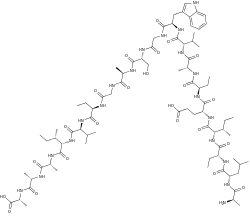Chemistry:Actagardin
From HandWiki

| |
| Names | |
|---|---|
| Systematic IUPAC name
(2R,5S,8R,11S,14S,17R,23R,26R,32R,35S,38R,41R,44R)-44-{(2S,3S)-2-[(2R)-2-{(2S)-2-[(2R)-2-Aminopropanamido]-4-methylpentanamido}butanamido]-3-methylpentanamido}-11-[(2S)-butan-2-yl]-17,41-diethyl-26-(hydroxymethyl)-32-[(1H-indol-3-yl)methyl]-2,5,8,23,38-pentamethyl-4,7,10,13,16,19,22,25,28,31,34,38,40,43-tetradecaoxo-14,35-di(propan-2-yl)-3,6,9,12,15,18,21,24,27,30,33,37,39,42-tetradecaazaheptatetracontanedioic acid | |
| Other names
Gardimycin
| |
| Identifiers | |
3D model (JSmol)
|
|
| ChemSpider | |
PubChem CID
|
|
| |
| |
| Properties | |
| C81H132N20O23 | |
| Molar mass | 1754.064 g·mol−1 |
Except where otherwise noted, data are given for materials in their standard state (at 25 °C [77 °F], 100 kPa). | |
| Infobox references | |
Tracking categories (test):
Actagardin (INN; also known as gardimycin) is a tetracyclic[1] peptide lantibiotic made by Actinoplanes brasiliensis.[2] It was discovered in 1975 by Lepetit S.p.A.[3] Its method of antibiotic activity involves the inhibition of peptidoglycan, preferentially targeting gram negative bacteria.[1]
References
- ↑ 1.0 1.1 "Actagardin (CAS 59165-34-3)" (in en). https://www.caymanchem.com/product/19940.
- ↑ "[Actinoplanes brasiliensis INA 3802--a producer of peptide antibiotics]". Antibiotiki i Khimioterapiia 44 (4): 5–8. 1999. PMID 10483488.
- ↑ "Gardimycin, a new antibiotic inhibiting peptidoglycan synthesis". Antimicrobial Agents and Chemotherapy 11 (3): 396–401. March 1977. doi:10.1128/AAC.11.3.396. PMID 404960.
 |

